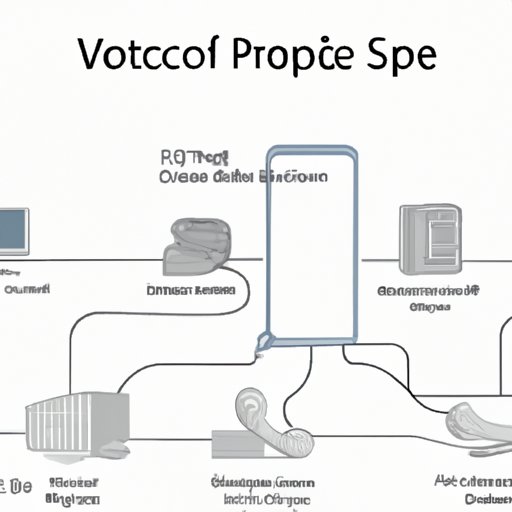Introduction
Voice over Internet Protocol (VoIP) is an innovative communication technology that enables users to make phone calls over the internet. It has become increasingly popular in recent years due to its cost-effectiveness, scalability, and flexibility. In this article, we’ll explore how VoIP works, discuss its benefits and challenges, and explain why it’s becoming an increasingly popular option for businesses.
Explaining VoIP: What is VoIP and How Does it Work?
VoIP is a type of technology that allows users to make phone calls over the internet. It works by converting analog audio signals into digital data, which is then transmitted over the internet. This process is known as “packet switching,” and it enables users to make high-quality phone calls without the need for traditional telephone lines.
The components of VoIP include hardware such as IP phones, software such as VoIP applications, and a broadband connection. IP phones are devices that look like traditional telephones but are designed to connect to the internet via an Ethernet cable. They allow users to make and receive calls using VoIP technology. VoIP applications are programs that enable users to make calls directly from their computers or mobile devices. Finally, a broadband connection is required to provide a reliable and high-speed internet connection for VoIP calls.
When making a VoIP call, the user’s voice is converted into digital data, which is then transmitted over the internet. The receiving device (e.g., another IP phone or computer) receives the data and converts it back into an audio signal. This process happens in real time, enabling users to communicate with each other in a seamless manner.
The Benefits of VoIP: Why VoIP is Becoming Increasingly Popular
VoIP technology offers several advantages over traditional phone systems. Chief among these is cost savings. According to a study conducted by the University of Texas at Austin, businesses can save up to 90% on their phone bills by switching to VoIP. Additionally, VoIP is much more flexible than traditional phone systems, as it can be used to make international calls without incurring additional charges.
VoIP is also highly scalable, meaning businesses can easily add or remove users as needed. This makes it ideal for companies that experience rapid growth or fluctuating demand. Finally, VoIP technology can be integrated with other business applications, such as customer relationship management (CRM) systems, which can further improve productivity.
VoIP Security: What Measures Are Taken to Ensure Calls Are Secure?
Security is a major concern when it comes to VoIP technology, as it involves transmitting sensitive data over the internet. To ensure calls are secure, VoIP providers employ a variety of measures. These include encryption, network security, and authentication.
Encryption is a process in which data is encoded so that only authorized users can access it. Most VoIP providers use 128-bit or 256-bit AES encryption, which is considered to be virtually unbreakable. Network security measures such as firewalls and intrusion detection systems are also employed to protect against malicious attacks.
Finally, authentication is used to verify the identity of users. This is done by requiring users to enter a username and password before they can make or receive calls. Authentication also helps to prevent unauthorized users from accessing the system.
Troubleshooting VoIP: Common Issues & Solutions
While VoIP technology is generally reliable, there are certain issues that may arise. Common problems include poor quality connections, network congestion, and equipment malfunction. Poor quality connections can be caused by slow internet speeds or interference from other Wi-Fi networks. Network congestion occurs when too many people are trying to access the same network at the same time, resulting in slower speeds and dropped calls. Equipment malfunction can occur if the hardware is not properly configured or if it is damaged.
Fortunately, most of these issues can be easily resolved. For example, slow internet speeds can be addressed by upgrading to a faster connection. Network congestion can be alleviated by limiting the number of simultaneous users. Finally, equipment malfunction can be resolved by replacing faulty hardware or reconfiguring existing hardware.
VoIP vs. Traditional Phone Systems: What’s the Difference?
VoIP and traditional phone systems differ in several key ways. First, VoIP systems offer a wide range of features that are not available with traditional systems, such as voicemail, caller ID, and conference calling. Additionally, VoIP systems tend to be much more cost-effective than traditional systems. Finally, VoIP systems require less maintenance than traditional systems, as they do not require any physical wiring or hardware installation.

VoIP for Businesses: How Companies Can Benefit from VoIP Technology
For businesses, VoIP technology can provide numerous benefits. Chief among these is cost savings. As mentioned earlier, businesses can save up to 90% on their phone bills by switching to VoIP. Additionally, VoIP can increase productivity by allowing employees to make and receive calls from anywhere with an internet connection. Finally, VoIP technology can improve customer service by providing features such as call forwarding, automated attendants, and voicemail.
Conclusion
VoIP technology is a powerful communication tool that offers numerous benefits, including cost savings, increased productivity, and improved customer service. It works by converting analog audio signals into digital data and transmitting them over the internet. To ensure calls are secure, VoIP providers employ a variety of measures, such as encryption, network security, and authentication. While VoIP technology does have some drawbacks, such as potential security risks, these can be minimized with proper precautions. Overall, VoIP is an excellent option for businesses looking to reduce costs and increase efficiency.
(Note: Is this article not meeting your expectations? Do you have knowledge or insights to share? Unlock new opportunities and expand your reach by joining our authors team. Click Registration to join us and share your expertise with our readers.)
